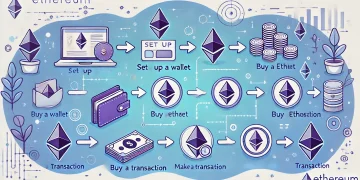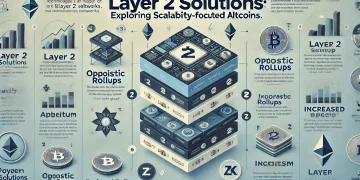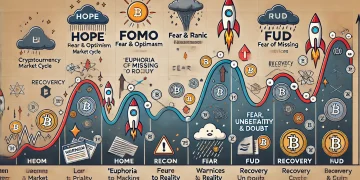1. What is Ethereum?
Ethereum is a decentralized, open-source blockchain platform that allows developers to build and deploy decentralized applications (DApps). Launched in 2015 by Vitalik Buterin and other co-founders, Ethereum enables the execution of smart contracts—self-executing agreements where the terms are directly written into code.
The native cryptocurrency of Ethereum is called Ether (ETH), which is used to pay for transactions, execute smart contracts, and incentivize participants who validate and secure the network.
2. How Does Ethereum Work?
At its core, Ethereum operates as a distributed network of computers (also known as nodes) that maintain a shared ledger of transactions and contracts. Unlike centralized systems, Ethereum is decentralized, meaning there’s no central authority controlling the network.
Ethereum’s blockchain is secured by a consensus mechanism known as Proof of Work (PoW), although it’s in the process of transitioning to Proof of Stake (PoS) with Ethereum 2.0. Nodes validate transactions, add them to the blockchain, and ensure the network remains secure. In return, validators (miners in PoW, stakers in PoS) earn ETH as a reward.
3. Ethereum vs. Bitcoin: Key Differences
Many newcomers confuse Ethereum with Bitcoin, as both are cryptocurrencies. However, there are some key differences:
- Purpose: Bitcoin is primarily designed as a digital currency and store of value. Ethereum, on the other hand, serves as a platform for building decentralized applications.
- Smart Contracts: Ethereum introduced the concept of smart contracts, enabling decentralized applications to automate processes and agreements. Bitcoin does not have this functionality.
- Transaction Speed: Ethereum transactions are generally faster than Bitcoin transactions.
- Consensus Mechanism: While both Ethereum and Bitcoin originally used Proof of Work, Ethereum is transitioning to Proof of Stake, which is more energy-efficient.
4. Why Use Ethereum?
There are several reasons why someone might want to use Ethereum:
- Smart Contracts: Ethereum allows developers to create self-executing contracts that operate without the need for intermediaries.
- Decentralized Applications (DApps): Ethereum supports thousands of DApps, which provide services ranging from decentralized finance (DeFi) to gaming.
- Investment: Many people invest in Ethereum’s cryptocurrency, Ether (ETH), either as a long-term store of value or to trade.
- DeFi: Ethereum hosts the majority of decentralized finance protocols, allowing users to borrow, lend, trade, and earn interest without traditional financial intermediaries.
5. How to Set Up a Cryptocurrency Wallet for Ethereum
Before you can buy, send, or receive Ethereum, you’ll need a cryptocurrency wallet. A wallet is essentially a software application that allows you to interact with the Ethereum network.
Types of Ethereum Wallets:
- Hardware Wallets: These are physical devices like Ledger or Trezor that store your private keys offline, providing enhanced security.
- Software Wallets: These wallets, such as MetaMask or MyEtherWallet, are applications you can install on your computer or smartphone. They’re more convenient but less secure than hardware wallets.
- Web Wallets: These are browser-based wallets like MetaMask or Coinbase Wallet, which allow you to manage your ETH directly from your web browser.
Setting Up a Wallet:
- Download a Wallet: Choose the type of wallet that suits your needs. MetaMask, for example, is a popular software wallet.
- Create an Account: Follow the instructions to create an account and write down your seed phrase. This phrase is crucial for recovering your wallet if you lose access to it.
- Secure Your Wallet: Make sure to enable two-factor authentication (2FA) and store your seed phrase in a safe location.
Once your wallet is set up, you’re ready to buy, send, and receive ETH.
6. How to Buy Ethereum (ETH)
Buying Ethereum is easier than ever, thanks to a variety of platforms that offer Ethereum trading services. Here’s how to do it:
Step 1: Choose a Cryptocurrency Exchange
To purchase ETH, you need to register with a cryptocurrency exchange. Some popular exchanges include:
- Coinbase: Ideal for beginners, Coinbase offers an easy-to-use interface and is available in many countries.
- Binance: Known for its low fees and wide range of cryptocurrency options.
- Kraken: Another reliable exchange with robust security measures and a wide range of trading features.
Step 2: Sign Up and Verify Your Identity
Most exchanges require you to create an account and verify your identity to comply with regulatory requirements (KYC – Know Your Customer).
Step 3: Deposit Funds
You can deposit funds into your exchange account using a bank transfer, credit card, or other payment methods offered by the platform.
Step 4: Buy Ethereum
Once your account is funded, search for Ethereum (ETH) on the exchange and place a buy order. You can buy Ethereum using market orders (buying at the current price) or limit orders (buying at a specific price).
7. Storing Ethereum Safely
After purchasing ETH, it’s essential to store it securely to prevent theft or hacking. Here are the most common storage options:
- Cold Storage: This involves storing your Ethereum offline, often in a hardware wallet like Ledger or Trezor. It is the most secure option as it is immune to online threats.
- Hot Wallets: These are online wallets, such as MetaMask, that store your private keys online. While convenient for frequent transactions, they are more vulnerable to hacking.
- Paper Wallets: A paper wallet is a physical document that contains your private and public keys. It is an offline storage option, but losing the paper means losing access to your funds.
For long-term storage, cold wallets are recommended, while hot wallets are ideal for frequent transactions.
8. How to Use Ethereum for Transactions
Once you own Ethereum, you can use it for transactions such as sending money, paying for services, or interacting with decentralized applications. Here’s how:
- Open Your Wallet: Access your cryptocurrency wallet (e.g., MetaMask, Ledger).
- Select ‘Send’: Choose the option to send ETH.
- Enter the Recipient’s Address: Input the Ethereum wallet address of the person or service you are sending ETH to. Be cautious and double-check the address, as transactions on the blockchain are irreversible.
- Set the Gas Fee: Ethereum transactions require a gas fee, which is paid in ETH. You can choose a higher gas fee for faster transactions or a lower fee if you’re not in a rush.
- Confirm the Transaction: Once you confirm, the transaction will be processed by the Ethereum network. Depending on the gas fee, it may take a few seconds to a few minutes.
9. Exploring Decentralized Applications (DApps) on Ethereum
One of Ethereum’s unique features is its ability to host decentralized applications (DApps). These applications run on the blockchain, making them transparent, secure, and resistant to censorship. Popular categories of DApps include:
- Finance: DApps like Aave, Uniswap, and MakerDAO allow users to lend, borrow, and trade cryptocurrencies without intermediaries.
- Gaming: Platforms like Decentraland and Axie Infinity allow users to play games and earn rewards in cryptocurrency.
- NFTs: DApps such as OpenSea and Rarible enable the creation, buying, and selling of non-fungible tokens (NFTs), unique digital assets like art or collectibles.
To use DApps, connect your wallet (e.g., MetaMask) to the application and interact directly with the Ethereum blockchain.
10. What is Ethereum Gas and How Does It Work?
Every transaction on Ethereum requires a gas fee, which compensates the network’s validators for processing and securing transactions. The amount of gas required depends on the complexity of the transaction.
Gas is measured in “Gwei,” a denomination of Ether. When network activity is high, gas fees can increase, making transactions more expensive. Users can choose to pay higher gas fees for faster transaction confirmation, or they can wait for lower fees during periods of low network usage.
11. Introduction to Smart Contracts
Smart contracts are self-executing agreements coded into the Ethereum blockchain. Once specific conditions are met, the contract automatically enforces the terms, eliminating the need for intermediaries. Some key features of smart contracts are:
- Automation: Once deployed, the contract automatically executes the terms when predefined conditions are met.
- Immutability: Once added to the blockchain, smart contracts cannot be altered.
- Transparency: The code behind smart contracts is open and visible on the blockchain, ensuring trust between parties.
Smart contracts have many applications, including insurance, supply chain management, and digital identity verification.
12. Introduction to Decentralized Finance (DeFi) on Ethereum
Decentralized Finance (DeFi) refers to financial applications built on Ethereum that operate without traditional financial intermediaries. DeFi enables users to lend, borrow, trade, and earn interest on their crypto assets in a decentralized manner. Popular DeFi platforms include:
- Uniswap: A decentralized exchange (DEX) that allows users to trade cryptocurrencies directly with one another.
- Aave: A lending and borrowing platform where users can earn interest by lending their crypto or take out loans.
- Compound: A DeFi protocol that lets users earn interest on their cryptocurrency holdings or take out loans.
DeFi is revolutionizing traditional finance by providing greater accessibility, lower costs, and increased transparency.
13. How to Stake Ethereum and Earn Rewards
Staking is an integral part of Ethereum 2.0, where users can earn rewards by locking up their ETH to help secure the network. Here’s how to get started:
- Stake ETH: To become a validator, you’ll need at least 32 ETH. Alternatively, you can join staking pools if you have less ETH.
- Set Up a Validator Node: If staking independently, you’ll need to set up a validator node, which requires technical knowledge and a stable internet connection.
- Earn Rewards: Validators are rewarded in ETH for proposing and validating blocks on the Ethereum network. Rewards are proportional to the amount staked and the duration of staking.
Staking is a way to earn passive income while contributing to the security and decentralization of the Ethereum network.
14. Security Tips for Ethereum Users
Security is paramount when dealing with cryptocurrencies. Here are some tips to help keep your Ethereum safe:
- Use a Hardware Wallet: Store your ETH in a hardware wallet to protect it from online threats.
- Enable Two-Factor Authentication (2FA): Secure your exchange accounts with 2FA for an extra layer of security.
- Beware of Phishing Attacks: Be cautious of emails or websites pretending to be legitimate exchanges or wallets. Always verify URLs and never share your private keys.
- Use Strong Passwords: Use unique, strong passwords for your wallets and accounts.
15. The Future of Ethereum
Ethereum is continuously evolving, with Ethereum 2.0 being the most significant upgrade in the pipeline. This upgrade will transition Ethereum from Proof of Work to Proof of Stake, improving scalability, security, and sustainability. Ethereum 2.0 will also introduce shard chains, which will allow the network to process more transactions simultaneously.
As Ethereum continues to grow, its ecosystem of DApps, DeFi, and NFTs is expected to expand, cementing its position as the leading platform for decentralized applications and smart contracts.
16. Conclusion: Start Your Ethereum Journey
Ethereum is more than just a cryptocurrency; it’s a platform for innovation, enabling the development of decentralized applications and services that are transforming industries. Whether you’re interested in investing, building applications, or exploring DeFi, Ethereum offers numerous opportunities.
By setting up a wallet, purchasing Ethereum, and learning how to use DApps and smart contracts, you can begin your journey into the world of blockchain technology. As Ethereum continues to evolve with Ethereum 2.0, now is the perfect time to get started and be part of this groundbreaking ecosystem.


























